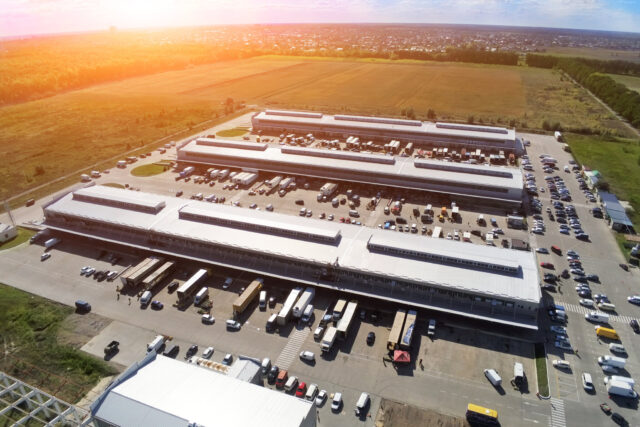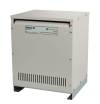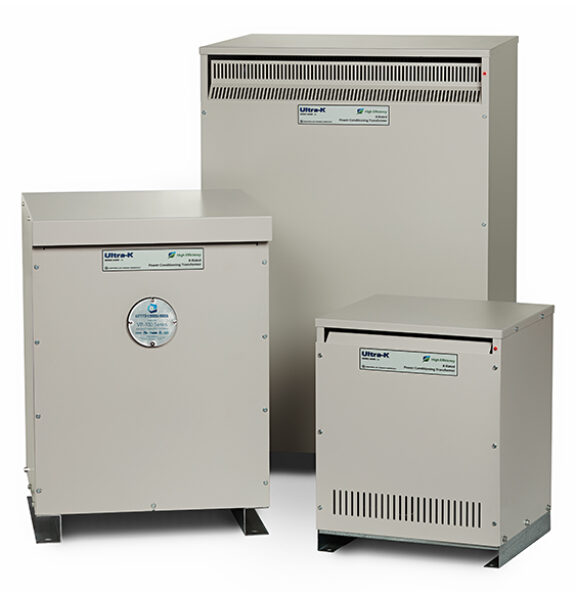Our team is here to support you and solve your power challenges. Connect with our responsive experts today to learn about our customized power solutions and products.
ULTRA-K Series 600K-he (5 kVA - 25 kVA ) Single Phase
High efficiency, K-rated power conditioning transformers which meet and exceed DOE 2016 minimum efficiency standards!
The ULTRA-K Series 600K-he is a high efficiency, K-rated, power conditioning transformer, specifically designed to provide a high degree of electrical noise attenuation and transient voltage suppression to protect sensitive electronic loads. Offered with four different K-factor ratings (K4, K7, K13, and K20), the ULTRA-K is fully compatible with non-linear loads, handling the high harmonic currents associated with such loads.
Single phase models include nominal input voltage options from 208VAC to 600VAC, with (2) 2.5% voltage taps FCAN, and (4) 2.5% voltage taps FCBN. Output voltage options include 120VAC, 120/240VAC, or 208VAC.
The ULTRA-K is provided in a NEMA 2 enclosure, or optional NEMA 3R.
Applications
- Audio/Video Recording Equipment
- IT Systems/Computers
- VFD Controls
- Automated Scanning Electronics
- Isolation For Uninterruptible Power Systems
- Laboratory Instrumentation
- Electronic Measurement
- Key Facilities and Industries Include Schools, Recording Studios, Performing Arts/Theaters, Wastewater Treatment, Pharmaceutical, Automated Manufacturing

Product Specifications
Features and Benefits
- Transformer power losses are lower than mandated by the DOE 2016 Standard, yielding a direct decrease in operating costs over the life of the transformer
- Double or triple shielded for high common mode noise attenuation from input to output; and also prohibits system back feed from noise generating load
- Optional output category B3 SPD (40kA per mode) with high frequency filter provides critical loads with optimum protection from noise, impulses, and high-energy voltage transients
- Optional output SPD (50 kA to 200 kA per phase), UL 1449 Listed, Type 2, including EMI/RFI filtering, Form C relay contacts, and LED status indicators
- Multiple K-factor ratings (K4, K7, K13, K20) allow proper application for both linear and non-linear loads … the higher the K-factor rating, the more harmonic current the transformer can handle
- Designed specifically to handle the harmonics and heating effects created by non-linear loads
- All-copper wound transformer construction allows the optimization of conductor size and geometry, to enhance harmonic-handling capability and transformer efficiency
- Standard, floor mounted enclosure: NEMA 2; optional NEMA 3R outdoor enclosure available
- Optional input and/or output circuit breaker(s) provided in a separate NEMA 1 enclosure for external mounting and installation
- Optional high/over temperature alarm contacts provided for tripping upstream breakers if required
- Optional industrial-grade IR scanning window(s) for safe, routine thermal scanning of transformer connections under load, without exposing personnel to arc flash hazards
- Optional lug kit available … mechanical (screw-type) lugs shipped for installer convenience
Performance Specs
- Efficiency: U.S. — Meets and exceeds U.S. Department of Energy (DOE) 2016 minimum efficiency standards identified under DOE 10 CFR Part 431
- Canada — Meets and exceeds CSA Standard C802.2-12
- Multiple Voltage Compensation Taps: Full capacity above/below nominal
- Output Impedance: 2% – 3.5% typical
- Output Distortion: Less than 1.0% THD added under linear load
- Load Regulation: 2% typical, no load to full load
- Overload: Up to 500% for 10 seconds, 1000% for 1 cycle
- Isolated Neutral: Establishes a new neutral to ground bond on the transformer’s output
- Common Mode Noise Attenuation: 126 dB (standard double shielding); 146 dB (optional triple shielding)
- Transverse Mode Noise Attenuation: 3 dB down at 10kHz, decaying 20 dB per decade; decaying 40 dB with “SPD With High Frequency Filter” option
- Operating Temperature: -25°C to +40°C
- Audible Noise: 45 to 50 dBA @ 1 meter (kVA size dependent)
- Temperature Rise: 135°C rise above ambient, under non-linear loading per UL 1561 standard
- UL 1561 Listed, labeled for operation at or below a specific K-factor rating
- C-UL Listed to CSA Standard C22.2, No 47-13
Single Phase Sizes
- 5kVA, 8kVA, 10kVA, 15kVA, 20kVA, 25kVA
Frequently Asked Questions
Does the ULTRA-K exceed the DOE 2016 minimum efficiency standard?
Yes! Efficiency for a given kVA size will vary from transformer to transformer, but the ULTRA-K’s design allows its efficiency to still exceed the minimum DOE-mandated level.
What is electrical noise, and what problem does it cause?
Electrical noise is a high frequency, low energy signal that travels on the power and ground lines of an electrical distribution system. This electrical noise can harm digital circuitry because the high frequencies can easily be coupled into the signal path and cause data corruption. This corruption often results in system upset, unexpected restarts, and nuisance equipment behavior.
How is electrical noise generated?
While conditions external to a facility can cause electrical noise and impulses, the majority of these disturbances are generated by electronic and electrical equipment within the facility. Examples of this equipment include photocopiers, lighting controls, variable speed drives, and motor loads.
How does the ULTRA-K attenuate electrical noise?
Noise attenuation is a function of the transformer itself and its ability to attenuate common mode noise (noise between the line and ground conductors) and transverse mode noise (noise between the line conductors). To address common mode noise, the ULTRA-K is manufactured using full-length electrostatic shields to minimize the capacitance between the primary and secondary of the transformer.rnrnProviding two shields greatly reduces this capacitance. Adding a third shield reduces the capacitance even more. By reducing this capacitive value, the electrical noise attenuation increases! The design and application of these shields are critical to the noise attenuation achieved. As for transverse mode noise, it is primarily the inductance of the transformer that determines the attenuation level, which is frequency-dependent.
Will a Surge Protection Device alone attenuate electrical noise?
No, not necessarily. A typical SPD is designed to protect against high-energy voltage transients, not electrical noise.
Why add a Surge Protection Device to the output of the ULTRA-K?
An SPD is designed to protect against high energy voltage transients by clamping them at a safe voltage level. It will ensure that dangerous high energy (and high voltage) transients never reach critical downstream equipment. The SPD is a perfect complement to the ULTRA-K transformer. Together, your critical equipment will be protected from both disruptive electrical noise and damaging high energy transients!
What is a K-factor?
It is a value used to determine how much harmonic current a transformer can handle without exceeding its maximum temperature rise level. K-factor values range from 1 to 50. K-factor of 1 is used for linear loads only, and a K-factor of 50 is used for the harshest harmonic environment possible. A K-factor of 7 to 13 is typical. When transformers use a K-factor value, they are said to be K-rated.
What is a K-rated transformer?
A K-rated transformer is one which is used to accommodate harmonic generating loads. Harmonics generate additional heat in the transformer and cause non-K-rated transformers to overheat, possibly causing a fire. K-rated transformers are sized appropriately to handle this additional heat, and are tested to UL 1561 rigorous standards.
How does a K-rated transformer handle the heat generated by harmonics?
To handle increased internal temperatures, either the geometry of the coil conductor is changed or multiple conductors are used to minimize the heating effect caused by load-generated harmonics. Quality transformers are also manufactured with a high grade silicon steel, copper windings, and more air ducts.
Where would I use a K-rated transformer?
Anywhere non-linear loads are present. New construction, renovations, factory automation, computer rooms, and office buildings are prime locations for K-rated transformers because of the type of equipment being used which generates harmonics.
How much K-rating do I need?
Typically a K-13 rated transformer is sufficient for most applications. Loads approaching 100% non-linear or more than 75% THD should incorporate a K-20 rated transformer.
Why are copper-wound transformers better than aluminum?
Copper has a higher current carrying capacity than aluminum, which is an important factor when designing K-rated transformers for harmonic-rich loads. Copper allows you to minimize the conductor used and optimize its geometry by using flat, rectangular wire to increase the surface area of the conductor. This reduces stray losses within the transformer, thus the heating effect from harmonics. Less power losses lead to higher efficiency.


